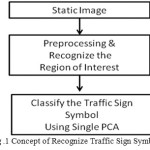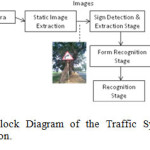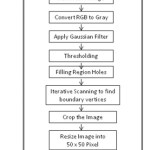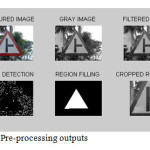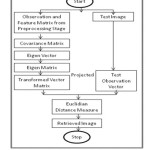Shashidhar T Halakatti1, Shambulinga T Halakatti2
1Department of Computer Science and Engineering ,Rural Engineering College, Hulkoti
2Department of Electronics & Communication Engineering ,BVVS Polytechnic, Bagalkot
Article Publishing History
Article Received on :
Article Accepted on :
Article Published : 30 Jun 2015
Article Metrics
ABSTRACT:
In this paper, the image processing method has been used to recognize traffic sign symbol from the static image. In this paper we have to recognize traffic sign symbol by using single dimension principal component analysis(sdpca).We have focused on traffic sign symbol of triangular shapes .Images are pre processed with several image preprocessing techniques, such as threshold techniques, Gaussian filter and Canny edge detection then the single dimension principal component analysis algorithm stages are performed to recognize the traffic sign symbol.
KEYWORDS:
Classification; Feature Extraction; Single Dimension PCA
Copy the following to cite this article:
Halakatti S. T, Halakatti S. T. Traffic Sign Symbol Recognition Using Single Dimension PCA. Orient.J. Comp. Sci. and Technol;8(2)
|
Copy the following to cite this URL:
Halakatti S. T, Halakatti S. T. Traffic Sign Symbol Recognition Using Single Dimension PCA. Orient. J. Comp. Sci. and Technol;8(2). Available from: http://www.computerscijournal.org/?p=1924
|
Introduction
If the vehicle have these technologies, then we save the life of driver as well as we can have great potential to save precious life of a driver. Now a days every vehicle are embedded with these kind of technologies for the safer drive.
For the driver to assist in the high ways. The traffic sign symbols are installed at the side of the road for precaution for the driver to safely drive and reach the destination properly.
This paper helps us to detections of traffic sign symbol in order to warn drivers to perform certain actions. Generally, traffic sign symbol provide the driver with a variety of information for safe and efficient navigation.
This paper is proposed to develop an efficient algorithm for recognize the traffic sign symbol in a static image. The objective of this algorithm is to reduce the search space in the static image and indicate only region of interest for the efficiency and accurate recognize the traffic sign symbol.
In the recent technologies, the identification and recognition of traffic signs have been developed in many research centers. A vision system for the traffic sign recognition and integrated autonomous vehicle was developed as part of the European research project Prometheus At Daimler-Benz Research center [1]. Moreover, many new technologies have been developed for traffic sign recognition. Recognition of traffic sign based on their color and shape features extracted using human vision model by X.W.Gao, L. Podladchokova, D.Shaposhnikov, K.Hong, N.Shevtso [3].However this took a more amount of time and resources. A genetic algorithm was also proposed by Aoyagi and Askura [4] to identify road sign from gray level images because of a limitation of crossover, mutation operator, and optimal solution. It is not guaranteed to achieve results. Colour indexing was proposed by Lalonde and Li [2] to approach identifying road sign, Unfortunately the computation time was not accepted in complex traffic scenes.
The paper is proposed in two phases. The First phase is related to the detection of traffic sign symbol in an static image. The Second phase is related to recognition of those detected traffic sign symbol , using single dimension principal component analysis.
This paper is proposed to develop to recognize the traffic sign symbol from the static image. The main objective is to reduce the search space and indicate only our region of interest for the efficiency and speed of the system. Fig. 1 illustrates the concept of Recognize Traffic Sign Symbol.
An algorithm is required to provide the necessary accuracy in recognition of traffic symbol sign. Here in the paper we segmented according to the sign properties of triangular shape. The traffic sign images are investigated to detect only the region of interest which make us easy to recognize the road signs from the complex background image.
The region of interest are then normalized to a specific size and input a recognition phase. This paper deals with the study of only triangle shaped objects because these shapes are concerned with direction signs.
A robust algorithm is required to provide the necessary accuracy in identification of traffic sign symbols.
The remaining of this paper is organized as follows Section 2 presents a system description of image processing stages to extract the dominant features. In Section 3 the description of single dimension principal component analysis is presented. Section 4 and 5 shows the representative experimental result analysis, conclusion and future work respectively.
System Description of Image Processing Stages
System Overview
The first section is Image extraction and sign detection and extraction stages. The static image have been taken from a high pixel camera and from that image, we are extracting our region of interest that is traffic sign symbol. The sign detection and extraction stage extracts all the traffic signs contained in the image and generates the small image that is region of interest called blobs.
Then each blob will be performed by a form recognition stage to be a valuable parameter input to the recognition stage, which is the final part, then the output of traffic sign symbol recognition will be presented. The description of the traffic sign symbol recognition system can be explained as the Traffic Sign Symbol Preprocessing stage and Recognition.
For the Traffic Sign Symbol Preprocessing stage, it is divided into two parts: Sign Detection and Extraction and Form Recognition stage. Fig 2. displays block diagram of the system description.
Preprocessing Stage
The first stage in the detection and recognition of traffic sign symbol is the pre-processing stage. The steps involved in the preprocessing stage are shown in the form of a flowchart in Fig .3.
The first step involves reading RGB image containing the traffic sign. This 3D RGB image is converted to a grayscale image. The image has 2D spatial co-ordinates with intensity values that fall within the range of 0-255. This conversion of the color image to grayscale image provides a better scope for manipulation.
A Gaussian filter is then applied to the grayscale image which sharpens the image. The main need for a filter is to remove the unwanted components(noise), thus in turn highlighting the prominent features. The gray-threshold of the filter image is then calculated.
In the Edge-Detection of the traffic sign we make use of the Canny Edge detection technique which makes use of the calculated gray threshold.
The Canny Edge detection method finds edges by looking for the local maxima of the gradient of the input image. It calculates the gradient using the derivative of the Gaussian filter. The Canny method uses two thresholds to detect strong and weak edges. It includes the weak edges in the output only if they are connected to strong edges. As a result, the method is more robust to noise, and more likely to detect true weak edges.
After the edge detection the unwanted region holes are filled. At the end of this step the image obtained is a black and white image with intensity value 1 for the traffic sign and intensity value 0 for the background.
Finally, the image obtained after filling the region holes is iteratively scanned to obtain the corner vertices of the traffic sign. A sub-image containing only the region of interest is cropped from the image according to the vertices.
The sub-image containing the region of interest that is the traffic sign is resized to a set standard of 50 x 50 pixels and is used as the input test image for the recognition stage.
Pre-processing Outputs
The following Fig .4 shows images after pre-processing.
Recognition Using Single Dimension Principal Component Analysis
The Single Dimension Principal Component Analysis is a way of identifying patterns in data and expressing the data in such a way as to highlight their similarities. Since patterns in data can be hard to find in data of high dimension, where the luxury of graphical representation is not available. SDPCA is a powerful tool for analyzing the data. The other main advantage of SDPCA it reduces the dimensionality without much loss of information.
Fig .5 shows the pictorial representation of single dimension principal component analysis.
Output of Recognition Stage
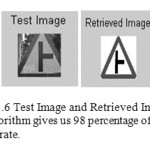 |
Figure6: Test Image and Retrieved Image.This algorithm gives us 98 percentage of successful recognition rate.
Click here to View figure
|
Conclusion and Future Work
Road Signs are deliberately designed and positioned to detect them and recognize what they mean. It is still a challenge to enable a computer as well as humans, especially over the full range of possible signs.
This paper has covered only triangular shaped signs. While the traffic sign symbol detection method is robust and accurate, sign recognition suffers because the extracted sign regions are small and often blurred. Actively pointing a camera at the locations of detected signs and zooming in would enable more accurate sign recognition.
References
- H. X. Liu, and B. Ran, “Vision-Based Stop Sign Detection and Recognition System for Intelligent Vehicle,” Transportation Research Board(TRB) Annual Meeting 2001, Washington, D.C., USA, January 7-11,2001.
CrossRef
- M. Lalonde, Y. Li, Detection of Road Signs Using Color Indexing, Technical Report CRIM-IT-95/12-49, Centre de Recherche Informatique de Montreal. Avaliable from: http://www.crim.ca/sbc/english/cime/publications.html, 1995
- X. Gao, N.Shevtsova, K. Hong, L.N. Podladchikova, D.G. Shaposhnikov, N.A. Shevtsova, “Recognition of traffic signs based on their colour and shape features extracted using human vision models,” Proceeding of Conference on NeuroInformatics, Mascow, 2002,63-69.
- Y. Aoyagi, T. Asakura, “ A study on traffic sign recognition in scene image using genetic algorithms and neutral networks”, Proceddings of the IEEE IECON Int. Conf. on Industrial Electrnics, Control, and Instrumentation, Taipei, Taiwan, vol. 3, 1996, pp. 1838-1843.

This work is licensed under a Creative Commons Attribution 4.0 International License.
